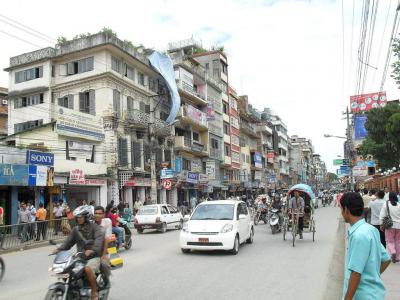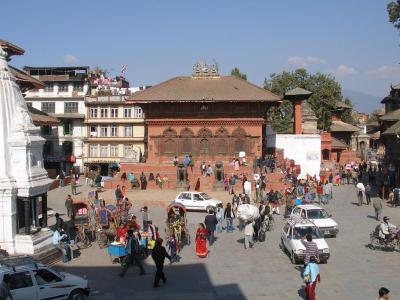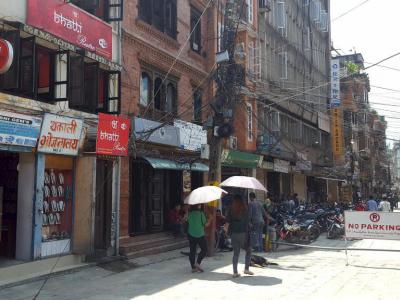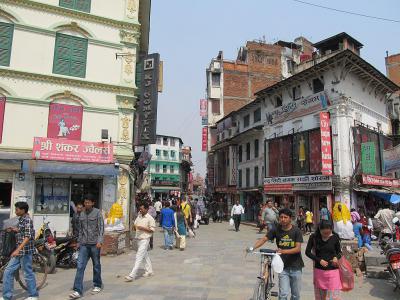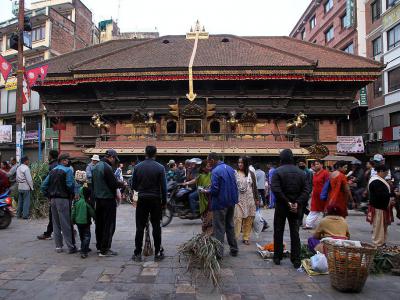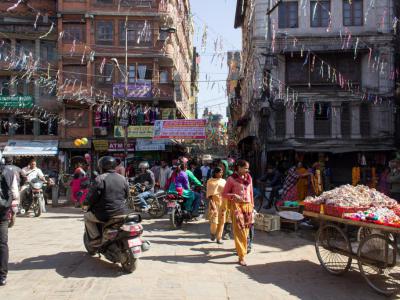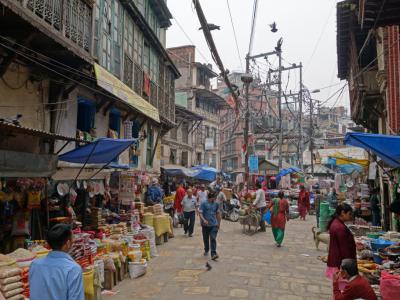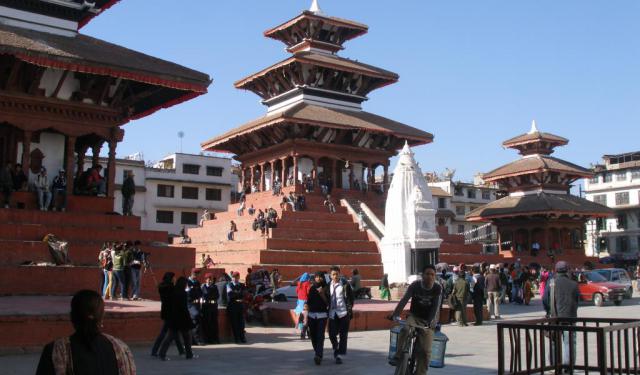Kathmandu's Street Markets Tour (Self Guided), Kathmandu
Ardent shoppers – those keen on street markets in particular – will find Kathmandu a true heaven. In this city, street markets are where you can buy some exotic (and often good-quality) products, such as monk's robes, soft silks, woolen garments, artifacts, and more, at very good prices. The list of bargains is truly endless. Sadly, however, in Kathmandu, you are not allowed to buy authentic antiques, but you can always buy copies.
New Road is a major commercial hub where you can find a wide range of goods, from clothing and electronics to handicrafts and jewelry – a perfect place for shopaholics to explore the latest trends and traditional Nepali products.
Durbar Square, a UNESCO World Heritage Site, is not only a historical and cultural center but also a vibrant marketplace. It is surrounded by small shops and stalls selling local crafts, souvenirs, and traditional artworks, making it a must-visit for tourists.
Old Freak Street, a historic area in Thamel, was once a haven for hippies in the 1960s. Today, it retains its bohemian charm and hosts a variety of shops offering vintage clothing, antiques, and quirky items.
Makhan Tole Street is famous for its religious significance, as it leads to the Akash Bhairab Temple. Along this street, you can find shops selling religious artifacts, incense, and other spiritual items.
Indra Chowk is another bustling area with numerous street vendors selling clothing, jewelry, and traditional Nepali handicrafts. The nearby Akash Bhairab Temple adds a touch of spirituality to the shopping experience.
Asan Bazar, known for its bustling atmosphere, is a popular market where you can purchase spices, herbs, and various foods. It's a sensory delight with its colorful displays and aromatic spices.
Thamel Bazar is a well-known tourist hotspot in Kathmandu. Here, you can find a wide array of shops catering to travelers' needs, including trekking gear, clothing, and souvenirs.
Undoubtedly, the numerous street markets of Kathmandu are one of its most charming aspects. We hereby invite you to stroll through these vibrant locations on our self-guided tour and immerse yourself in the rich tapestry of Kathmandu's marketplaces. Happy shopping!
New Road is a major commercial hub where you can find a wide range of goods, from clothing and electronics to handicrafts and jewelry – a perfect place for shopaholics to explore the latest trends and traditional Nepali products.
Durbar Square, a UNESCO World Heritage Site, is not only a historical and cultural center but also a vibrant marketplace. It is surrounded by small shops and stalls selling local crafts, souvenirs, and traditional artworks, making it a must-visit for tourists.
Old Freak Street, a historic area in Thamel, was once a haven for hippies in the 1960s. Today, it retains its bohemian charm and hosts a variety of shops offering vintage clothing, antiques, and quirky items.
Makhan Tole Street is famous for its religious significance, as it leads to the Akash Bhairab Temple. Along this street, you can find shops selling religious artifacts, incense, and other spiritual items.
Indra Chowk is another bustling area with numerous street vendors selling clothing, jewelry, and traditional Nepali handicrafts. The nearby Akash Bhairab Temple adds a touch of spirituality to the shopping experience.
Asan Bazar, known for its bustling atmosphere, is a popular market where you can purchase spices, herbs, and various foods. It's a sensory delight with its colorful displays and aromatic spices.
Thamel Bazar is a well-known tourist hotspot in Kathmandu. Here, you can find a wide array of shops catering to travelers' needs, including trekking gear, clothing, and souvenirs.
Undoubtedly, the numerous street markets of Kathmandu are one of its most charming aspects. We hereby invite you to stroll through these vibrant locations on our self-guided tour and immerse yourself in the rich tapestry of Kathmandu's marketplaces. Happy shopping!
How it works: Download the app "GPSmyCity: Walks in 1K+ Cities" from Apple App Store or Google Play Store to your mobile phone or tablet. The app turns your mobile device into a personal tour guide and its built-in GPS navigation functions guide you from one tour stop to next. The app works offline, so no data plan is needed when traveling abroad.
Kathmandu's Street Markets Tour Map
Guide Name: Kathmandu's Street Markets Tour
Guide Location: Nepal » Kathmandu (See other walking tours in Kathmandu)
Guide Type: Self-guided Walking Tour (Sightseeing)
# of Attractions: 7
Tour Duration: 1 Hour(s)
Travel Distance: 2.2 Km or 1.4 Miles
Author: helenp
Sight(s) Featured in This Guide:
Guide Location: Nepal » Kathmandu (See other walking tours in Kathmandu)
Guide Type: Self-guided Walking Tour (Sightseeing)
# of Attractions: 7
Tour Duration: 1 Hour(s)
Travel Distance: 2.2 Km or 1.4 Miles
Author: helenp
Sight(s) Featured in This Guide:
- New Road
- Durbar Square
- Old Freak Street
- Makhan Tole Street
- Indra Chowk and Akash Bhairab Temple
- Asan Bazar
- Thamel Bazar
1) New Road
New Road stands as the bustling financial heart and vibrant main street in Kathmandu. It denotes a narrow two-lane thoroughfare nestled within the heart of the city, along with its surrounding vicinity. Positioned close to the midpoint of Kathmandu's ring road and the historic center, including Kathmandu Durbar Square, also known as Basantapur, it holds significant prominence within the urban landscape.
Functioning as one of the primary commercial hubs, New Road teems with activity, offering a plethora of imported luxury goods of premium quality. Among its array of offerings, several quaint shops specialize in traditional Nepali musical instruments like fiddles and flutes, while also featuring iconic souvenirs such as the khukri - a ceremonial knife.
This road's inception dates back to the era of Prime Minister Juddha Shumsher Jung Bahadur Rana, following the devastation wrought by the 1934 Nepal–India earthquake in the Kathmandu Valley. Originally christened Juddha Sadak in his honor, it also holds historical significance as the former Kings Way of Nepal, leading to the erstwhile royal palace within Kathmandu Durbar Square, a UNESCO World Heritage Site.
New Road's eastern terminus hosts the headquarters of Nepal Airlines, adjacent to New Road Gate, marking the road's outset at the intersection with Kantipath. At the road's westernmost roundabout stands a statue commemorating Juddha Shumsher Jung Bahadur Rana. Moreover, New Road accommodates the head offices of Gorkhapatra Sansthan and Nepal Bank Limited, alongside the scenic Bhughol Park situated at its southwestern corner.
Functioning as one of the primary commercial hubs, New Road teems with activity, offering a plethora of imported luxury goods of premium quality. Among its array of offerings, several quaint shops specialize in traditional Nepali musical instruments like fiddles and flutes, while also featuring iconic souvenirs such as the khukri - a ceremonial knife.
This road's inception dates back to the era of Prime Minister Juddha Shumsher Jung Bahadur Rana, following the devastation wrought by the 1934 Nepal–India earthquake in the Kathmandu Valley. Originally christened Juddha Sadak in his honor, it also holds historical significance as the former Kings Way of Nepal, leading to the erstwhile royal palace within Kathmandu Durbar Square, a UNESCO World Heritage Site.
New Road's eastern terminus hosts the headquarters of Nepal Airlines, adjacent to New Road Gate, marking the road's outset at the intersection with Kantipath. At the road's westernmost roundabout stands a statue commemorating Juddha Shumsher Jung Bahadur Rana. Moreover, New Road accommodates the head offices of Gorkhapatra Sansthan and Nepal Bank Limited, alongside the scenic Bhughol Park situated at its southwestern corner.
2) Durbar Square (must see)
Durbar Square is a royal palace complex in Kathmandu. The square's full name is Hanuman Dhoka Durbar Square, named after the statue of Hanuman, a Hindu god, situated at the entrance.
The first royal palaces were constructed during the third century. Due to repeat reconstruction, nothing is left of those first buildings. Several structures around Durbar Square collapsed in 2015 when a 7.9 magnitude earthquake struck the region. The oldest building destroyed was the 7th-century Kasthamandap, a three-storied temple enshrining the deity of Gorakhnath.
It is thought that the existing palaces were built in the 10th century by Gunakamadeva, the ruler who founded the city of Kathmandu. They were not declared royal palaces until sometime during the reign of King Ratna Malla in the late 15th or early 16th century. The Durbar Square was the center of power until 1896 but continues to be used for coronations.
Structures around the complex include the 16th-century temples of Jagannath, Kotilingeshwara, Mahadev, Mahendreshwara, and Taleju. Other temples are the 18th-century Bhagavati Temple and the 17th-century Degutale Temple.
The Gaddi Durbar Neoclassical Palace was built in Durbar Square in 1908. It was designed in European architectural style with Greek columns and white plaster. The palace was used for coronations and to welcome heads of state from other countries. The Kumari Chock, a red-colored royal palace at the southern end of Durbar Square, is an even more popular attraction. It consists of the Raj Kumari or the Living Goddess, a preadolescence girl in a gilded cage, thought to be the human incarnation of the goddess Durga.
The Hanuman Dhoka Palace is open to visitors. Tourists can see the staterooms and the museums. The two museums inside the Hanuman Dhoka Palace are the King Tribhuvan Memorial Museum and the Mahendra Museum.
Durbar Square is a UNESCO World Heritage Site.
The first royal palaces were constructed during the third century. Due to repeat reconstruction, nothing is left of those first buildings. Several structures around Durbar Square collapsed in 2015 when a 7.9 magnitude earthquake struck the region. The oldest building destroyed was the 7th-century Kasthamandap, a three-storied temple enshrining the deity of Gorakhnath.
It is thought that the existing palaces were built in the 10th century by Gunakamadeva, the ruler who founded the city of Kathmandu. They were not declared royal palaces until sometime during the reign of King Ratna Malla in the late 15th or early 16th century. The Durbar Square was the center of power until 1896 but continues to be used for coronations.
Structures around the complex include the 16th-century temples of Jagannath, Kotilingeshwara, Mahadev, Mahendreshwara, and Taleju. Other temples are the 18th-century Bhagavati Temple and the 17th-century Degutale Temple.
The Gaddi Durbar Neoclassical Palace was built in Durbar Square in 1908. It was designed in European architectural style with Greek columns and white plaster. The palace was used for coronations and to welcome heads of state from other countries. The Kumari Chock, a red-colored royal palace at the southern end of Durbar Square, is an even more popular attraction. It consists of the Raj Kumari or the Living Goddess, a preadolescence girl in a gilded cage, thought to be the human incarnation of the goddess Durga.
The Hanuman Dhoka Palace is open to visitors. Tourists can see the staterooms and the museums. The two museums inside the Hanuman Dhoka Palace are the King Tribhuvan Memorial Museum and the Mahendra Museum.
Durbar Square is a UNESCO World Heritage Site.
3) Old Freak Street
Old Freak Street is a small street located near Durbar Square. It was given the name Freak Street, as it was the center of the hippie trail of Kathmandu during the 1960s and 1970s.
The primary attraction to Freak Street during the 1960s was the government-run hashish shops. With few places offering legal hashish, the hippie trail brought visitors from all over the world. The area became filled with artists who added their flavor to the art and architecture of Kathmandu.
The Government of Nepal began to impose dress codes and regulations on tourists in the 1970s. They also banned the production and sale of hashish, which caused the hippie movement to disappear.
Today, Old Freak Street serves as a reminder of the Hippie Trail. Visitors will find shops and restaurants where the hashish stores used to be. They also have access to Kumari Ghar, the palace of the living goddess Kumari.
The primary attraction to Freak Street during the 1960s was the government-run hashish shops. With few places offering legal hashish, the hippie trail brought visitors from all over the world. The area became filled with artists who added their flavor to the art and architecture of Kathmandu.
The Government of Nepal began to impose dress codes and regulations on tourists in the 1970s. They also banned the production and sale of hashish, which caused the hippie movement to disappear.
Today, Old Freak Street serves as a reminder of the Hippie Trail. Visitors will find shops and restaurants where the hashish stores used to be. They also have access to Kumari Ghar, the palace of the living goddess Kumari.
4) Makhan Tole Street
Makhan Tole, also known as Makhan Tol, is a vibrant and culturally rich street located in the heart of Kathmandu, Nepal, just north of the iconic Durbar Square. This area is a must-visit for those who are passionate about exploring the cultural and artistic heritage of Kathmandu. It offers a deep dive into the local fine arts scene, especially known for its shops selling thangka and paubha paintings.
Thangka, a traditional form of Tibetan art, features detailed embroidery on silk cloth, depicting Buddhist deities or mandalas, which are spiritual and ritual symbols in Hinduism and Buddhism representing the universe. Paubha is the Nepalese counterpart to thangka and involves scroll paintings that are highly revered in local culture.
Makhan Tole stretches from the northern part of Durbar Square, past the Tana Deval Temple, and towards Thamel. As you wander through this area, you can expect to encounter a plethora of shops offering various fine arts, numerous small but beautifully crafted temples, and a bustling atmosphere filled with intriguing sights and people. The street is a favorite among shoppers looking for authentic artistic items and those keen on immersing themselves in Kathmandu’s unique urban tapestry. This area encapsulates the essence of Kathmandu, with its blend of spiritual sites and vibrant market life, making it an essential experience for anyone visiting the city.
Thangka, a traditional form of Tibetan art, features detailed embroidery on silk cloth, depicting Buddhist deities or mandalas, which are spiritual and ritual symbols in Hinduism and Buddhism representing the universe. Paubha is the Nepalese counterpart to thangka and involves scroll paintings that are highly revered in local culture.
Makhan Tole stretches from the northern part of Durbar Square, past the Tana Deval Temple, and towards Thamel. As you wander through this area, you can expect to encounter a plethora of shops offering various fine arts, numerous small but beautifully crafted temples, and a bustling atmosphere filled with intriguing sights and people. The street is a favorite among shoppers looking for authentic artistic items and those keen on immersing themselves in Kathmandu’s unique urban tapestry. This area encapsulates the essence of Kathmandu, with its blend of spiritual sites and vibrant market life, making it an essential experience for anyone visiting the city.
5) Indra Chowk and Akash Bhairab Temple
Indra Chowk is a lively market square in Kathmandu. It houses colorful shops and stalls that sell a variety of wares. Visitors will see spices, textiles, beads, jewelry, ornaments, and produce. Street food stands serve traditional Nepali foods. The square is named after Indra, lord of heaven in Hindu mythology.
There are two primary temples in Indra Chowk square. These are the Seto Machindranath Temple and the Akash Bhairab Temple. The Akash Bhairab Temple is guarded by gilded statues that sit atop the entrance on a balcony.
Akash Bhairab Temple is thought to have been the palace of King Yalambar, the first king of Nepal. The head of Akash Bhairab is said to hold the spirit of the king. He is known as the God of the Sky.
The large head of Akash Bhairab is removed during the Yenya Festival each September and blessed by the living goddess Kumari. During the ceremony, a large number of worshippers come to visit the temple. They bring gifts of flowers, money, and food.
There are two primary temples in Indra Chowk square. These are the Seto Machindranath Temple and the Akash Bhairab Temple. The Akash Bhairab Temple is guarded by gilded statues that sit atop the entrance on a balcony.
Akash Bhairab Temple is thought to have been the palace of King Yalambar, the first king of Nepal. The head of Akash Bhairab is said to hold the spirit of the king. He is known as the God of the Sky.
The large head of Akash Bhairab is removed during the Yenya Festival each September and blessed by the living goddess Kumari. During the ceremony, a large number of worshippers come to visit the temple. They bring gifts of flowers, money, and food.
6) Asan Bazar
Asan Bazar is a traditional market and residential square located in the historical center of Kathmandu. Numerous shops stand, and street vendors line the square where five busy streets converge. Shoppers come from throughout the city, making it a lively place for tourism, people-watching, and circulating with locals.
The history of the Asan Market dates to ancient times. Because Kathmandu is one of the oldest continuously inhabited cities in the world, the Market has been a mainstay in the region before most of the architecture was in place.
Asan Market offers a large variety of goods. Shoppers will find food, spices, textiles, electronics, candles, religious items, cosmetics, incense, and souvenirs.
Tourists will see many attractive places near Asan Market. The Temple of Annapurna Ajima and the Temple of Ganesh are the most beautiful structures. The Temple of Annapurna Ajima honors the goddess of food and grain, apt for an area riffed with food and grain products for sale.
The history of the Asan Market dates to ancient times. Because Kathmandu is one of the oldest continuously inhabited cities in the world, the Market has been a mainstay in the region before most of the architecture was in place.
Asan Market offers a large variety of goods. Shoppers will find food, spices, textiles, electronics, candles, religious items, cosmetics, incense, and souvenirs.
Tourists will see many attractive places near Asan Market. The Temple of Annapurna Ajima and the Temple of Ganesh are the most beautiful structures. The Temple of Annapurna Ajima honors the goddess of food and grain, apt for an area riffed with food and grain products for sale.
7) Thamel Bazar
Thamel Bazar, located in the bustling Thamel neighborhood of Kathmandu, is a vibrant commercial hub that has been central to the tourist industry in the region for over four decades. Thamel first gained popularity during the hippie era, becoming a sanctuary for artists and a focal point for visitors from around the world. This neighborhood is particularly noted for its intricate network of narrow alleys, which are lined with a diverse array of shops and vendors.
The offerings in Thamel Bazar are vast, including a rich selection of food items like fresh vegetables and fruits, pastries, as well as various types of merchandise such as trekking and walking gear, music, DVDs, handicrafts, souvenirs, woolen goods, and clothing. Additionally, the area is well-equipped to cater to the needs of adventurers and tourists with its plethora of travel agencies, mountaineering gear shops, foreign money exchange booths, mobile phone outlets, and an array of budget hotels, guest houses, and small grocery stores.
Thamel is not only a shopping destination but also a cultural hotspot. It is known as one of the biggest shopping markets in Kathmandu, with both branded and local outlets offering products in Western and traditional Nepali styles. This market is a favored spot among foreign tourists, who enjoy the vibrant shopping experience and the unique offerings that blend Western and Nepali influences.
The area is also renowned for its nightlife, with numerous pubs and clubs providing lively entertainment options. The range of restaurants and cafes in Thamel is impressive, offering both traditional Nepali and continental cuisines. For those interested in live music and cultural events, Thamel does not disappoint, hosting a variety of venues that attract both local and international visitors.
The offerings in Thamel Bazar are vast, including a rich selection of food items like fresh vegetables and fruits, pastries, as well as various types of merchandise such as trekking and walking gear, music, DVDs, handicrafts, souvenirs, woolen goods, and clothing. Additionally, the area is well-equipped to cater to the needs of adventurers and tourists with its plethora of travel agencies, mountaineering gear shops, foreign money exchange booths, mobile phone outlets, and an array of budget hotels, guest houses, and small grocery stores.
Thamel is not only a shopping destination but also a cultural hotspot. It is known as one of the biggest shopping markets in Kathmandu, with both branded and local outlets offering products in Western and traditional Nepali styles. This market is a favored spot among foreign tourists, who enjoy the vibrant shopping experience and the unique offerings that blend Western and Nepali influences.
The area is also renowned for its nightlife, with numerous pubs and clubs providing lively entertainment options. The range of restaurants and cafes in Thamel is impressive, offering both traditional Nepali and continental cuisines. For those interested in live music and cultural events, Thamel does not disappoint, hosting a variety of venues that attract both local and international visitors.
Walking Tours in Kathmandu, Nepal
Create Your Own Walk in Kathmandu
Creating your own self-guided walk in Kathmandu is easy and fun. Choose the city attractions that you want to see and a walk route map will be created just for you. You can even set your hotel as the start point of the walk.
Pashupatinath Temple Complex Tour
Pashupatinath Temple Complex in Kathmandu is a sacred religious site that holds great significance for Hindus worldwide. The area in which it is located, near the Tribhuvan International Airport, is truly picturesque - surrounded by virgin jungle. This complex encompasses several notable locations, each contributing to its spiritual and cultural importance.
At the heart of the complex stands... view more
Tour Duration: 1 Hour(s)
Travel Distance: 1.8 Km or 1.1 Miles
At the heart of the complex stands... view more
Tour Duration: 1 Hour(s)
Travel Distance: 1.8 Km or 1.1 Miles
Kathmandu Introduction Walking Tour
Kathmandu is the capital city of Nepal. With nearly 3 million residents in the metropolitan region, Kathmandu is also the largest city in the country. Kathmandu is notable for being one of the oldest continuously inhabited cities in the world.
The name "Kathmandu" comes from the name of the Kasthamanadap pavilion in Durbar Square. That name comes from the Sanskrit words for... view more
Tour Duration: 2 Hour(s)
Travel Distance: 2.9 Km or 1.8 Miles
The name "Kathmandu" comes from the name of the Kasthamanadap pavilion in Durbar Square. That name comes from the Sanskrit words for... view more
Tour Duration: 2 Hour(s)
Travel Distance: 2.9 Km or 1.8 Miles
The Most Popular Cities
/ view all



